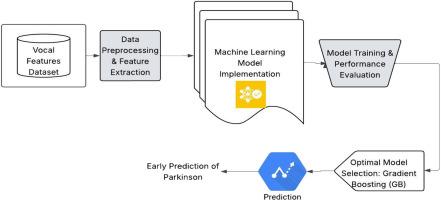Vocal features based Parkinson’s detection: An ensemble learning approach
IF 1.9
Q2 MULTIDISCIPLINARY SCIENCES
引用次数: 0
Abstract
Parkinson’s disease (PD) primarily affects the central nervous system. In 2019, over 8.5 million cases were reported, with numbers continuing to rise. This growing prevalence emphasizes the urgent need for early detection and preventive strategies. To resolve this, numerous methods have been introduced, one of them being machine learning technique. By employing deep learning methods on the large-scale datasets, the early prediction and detection of PD is possible. These methods should be precisely evaluated on the basis of vocal features and the best method to predict this neurodegenerative ailment is disclosed. The core objective of this research is to facilitate the medical centers by providing an optimal machine learning technique to early detect PD. In order to decide an ideal method, the renowned machine learning algorithms like Random Forest, K Nearest Neighbor, Naïve Bayes, Gradient Boosting and XGBoost are evaluated according to their performance. Gradient Boosting outperforms earlier results with high recall, low log loss, and overfitting resistance.
Vocal features proved to be valuable indicators for early-stage Parkinson’s detection.
The Gradient Boosting model has scored the highest in terms of all the mentioned parameters, showing a promising result for predicting the occurrence of PD.
Machine learning can play a significant role in supporting clinical diagnosis and decision-making.

基于声音特征的帕金森病检测:一种集成学习方法
帕金森病(PD)主要影响中枢神经系统。2019年,报告了850多万例病例,这一数字还在继续上升。这种日益增长的流行强调迫切需要早期发现和预防战略。为了解决这个问题,已经引入了许多方法,其中之一就是机器学习技术。通过在大规模数据集上采用深度学习方法,PD的早期预测和检测成为可能。这些方法应根据声音特征进行精确评估,并揭示了预测这种神经退行性疾病的最佳方法。本研究的核心目标是通过提供最佳的机器学习技术来促进医疗中心早期检测PD。为了确定一个理想的方法,我们根据随机森林、K近邻、Naïve贝叶斯、梯度增强和XGBoost等著名的机器学习算法的性能进行评估。梯度增强在高召回率、低对数损失和抗过拟合方面优于早期的结果。声音特征被证明是早期帕金森病检测的有价值的指标。Gradient Boosting模型在上述所有参数中得分最高,在预测PD的发生方面显示出很好的效果。机器学习可以在支持临床诊断和决策方面发挥重要作用。
本文章由计算机程序翻译,如有差异,请以英文原文为准。
求助全文
约1分钟内获得全文
求助全文
来源期刊

MethodsX
Health Professions-Medical Laboratory Technology
CiteScore
3.60
自引率
5.30%
发文量
314
审稿时长
7 weeks
期刊介绍:
 求助内容:
求助内容: 应助结果提醒方式:
应助结果提醒方式:


